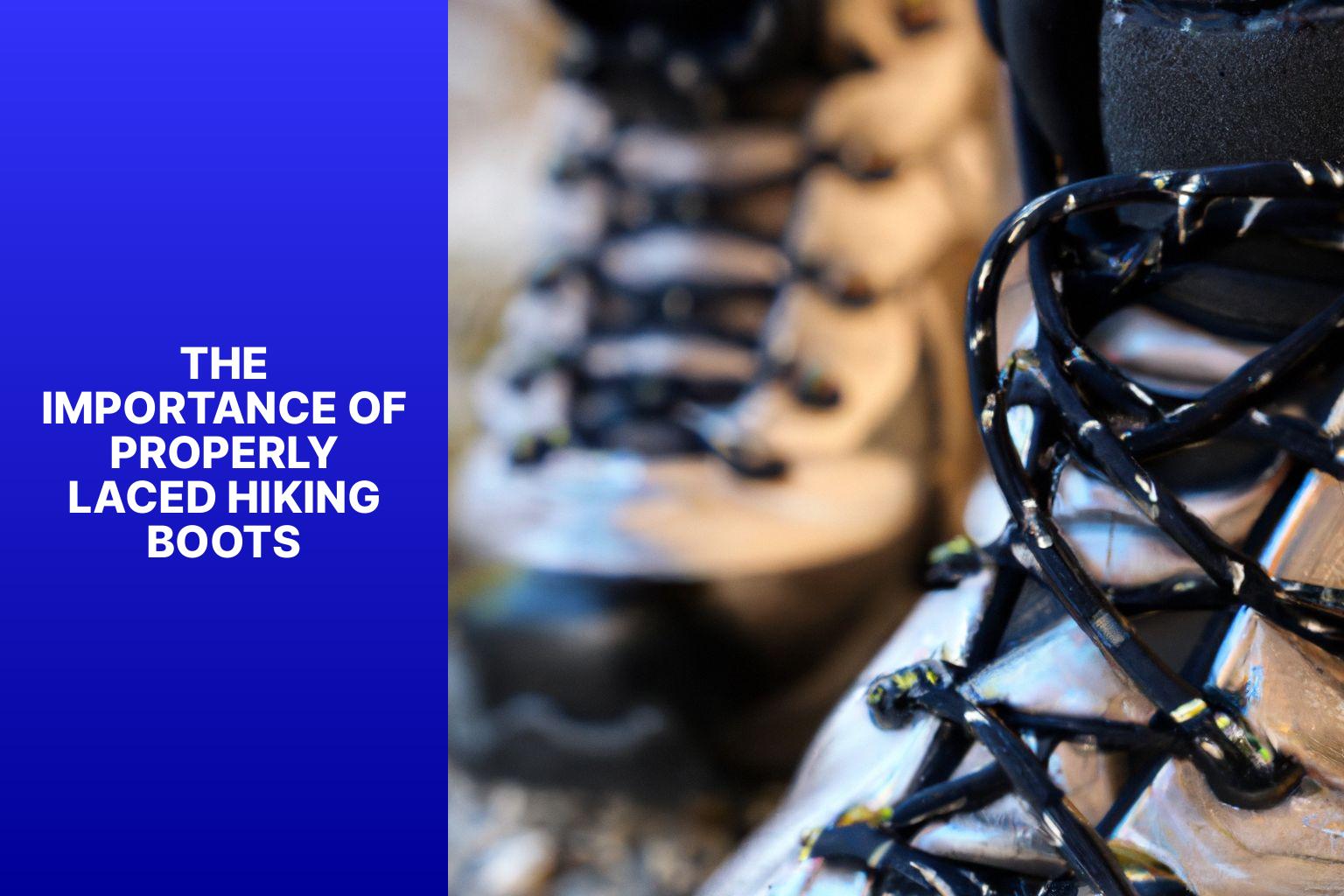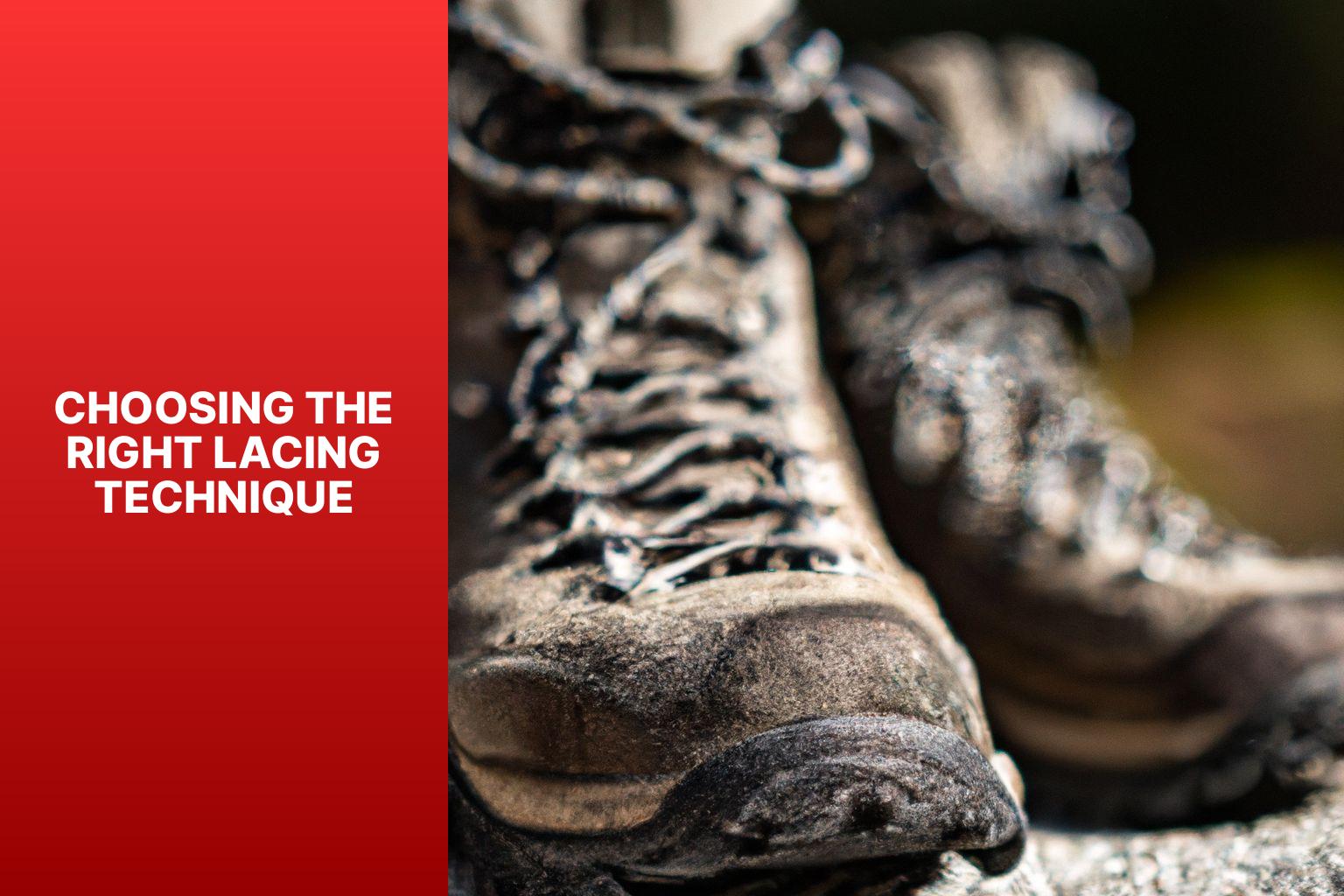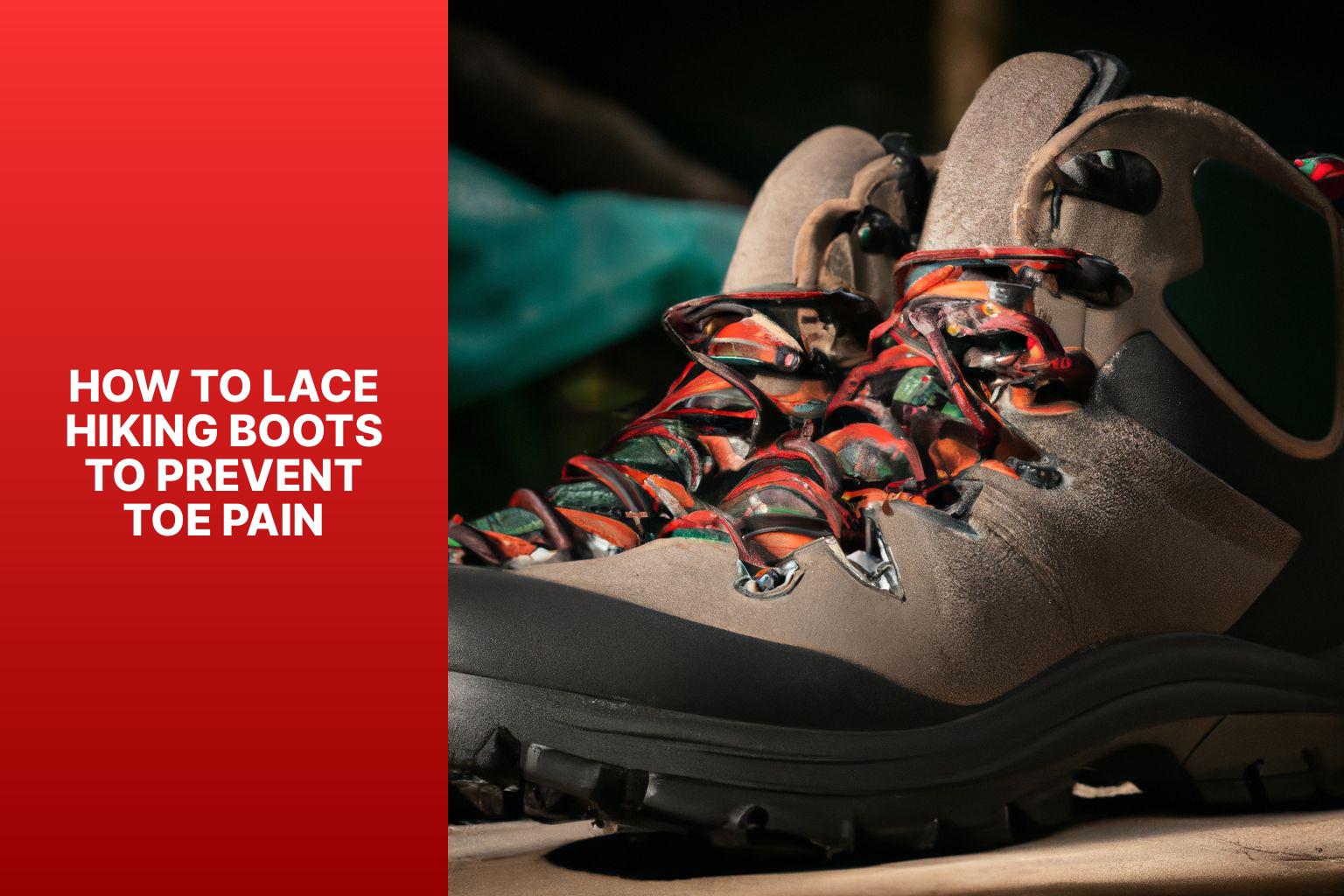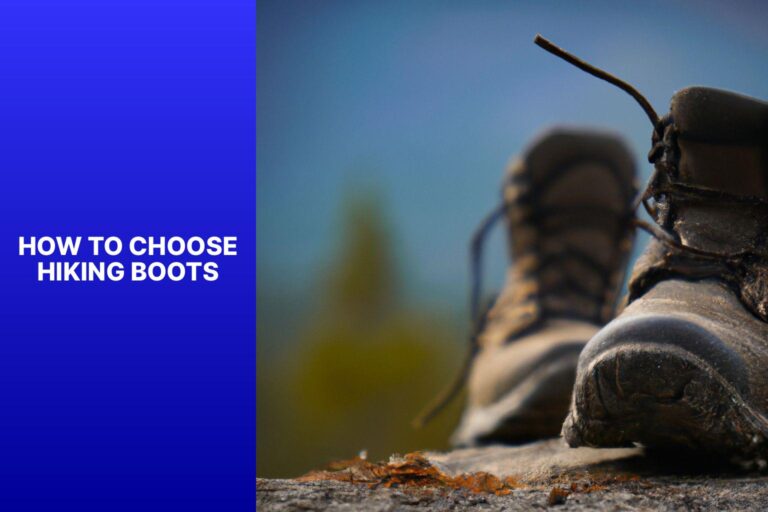How to Lace Hiking Boots to Prevent Toe Pain
Properly lacing your hiking boots is crucial for a comfortable and pain-free hiking experience. Toe pain is a common issue that hikers face, but it can be prevented by using the right lacing techniques. Understanding the importance of properly laced hiking boots and the underlying causes of toe pain is the first step to finding a solution. Tight toe boxes, insufficient arch support, and improper fit are the main culprits behind toe pain. In this article, we will explore different lacing techniques that can provide relief and prevent toe pain during your hikes. These techniques include the toe-relieving lacing technique, heel lock lacing technique, and wide foot lacing technique. We will provide tips such as proper footwear sizing, using insoles or arch supports, wearing toe protectors or caps, and gradually breaking in new hiking boots to further prevent toe pain. So, let’s dive in and learn how to lace your hiking boots to effectively prevent toe pain and ensure a comfortable hiking experience.
Key takeaway:
- Properly laced hiking boots are important to prevent toe pain: Proper lacing techniques can help alleviate toe pain and discomfort during hiking.
- Causes of toe pain in hiking boots include tight toe boxes, insufficient arch support, and improper fit: Understanding these causes can help prevent toe pain.
- Choosing the right lacing technique is crucial: Techniques like toe relieving, heel lock, and wide foot lacing can provide added comfort and prevent toe pain.
- Tips to prevent toe pain during hiking include proper footwear sizing, using insoles or arch supports, wearing toe protectors or caps, and gradually breaking in new hiking boots: These measures can help ensure a pain-free hiking experience.
The Importance of Properly Laced Hiking Boots

Photo Credits: Jasonexplorer.Com by Dennis Nelson
The importance of properly laced hiking boots cannot be overstated. Properly laced boots offer superior support, enhance stability, and improve your overall hiking experience.
The tightness and placement of the laces keep your feet secure, minimizing the risk of injuries. The laces also distribute pressure evenly, reducing the chances of developing blisters or hot spots.
By preventing unnecessary movement, properly laced boots allow you to fully concentrate on your hike and enjoy the outdoor surroundings. Properly laced boots prolong their lifespan by avoiding premature wear and tear.
To ensure a safe and enjoyable adventure, take the time to lace up your boots correctly before hitting the trails.
Causes of Toe Pain in Hiking Boots
Toe pain is a common issue faced by hikers, but understanding the causes can help tackle it head-on. In this section, we will uncover the culprits behind toe pain in hiking boots. From a tight toe box to insufficient arch support and improper fit, we’ll explore the sub-sections that shed light on these different causes. So, put on your detective hat as we dive into the factors that can make every step on your hiking journey a pain-free one.
1. Tight Toe Box
In hiking boots, a tight toe box can lead to discomfort and pain in the toes. To address this issue, it is important to consider the following factors:
- Toe box width: This is the front part of the boot where the toes are positioned. If the toe box is too narrow, it can squeeze the toes together, causing discomfort. It is recommended to look for hiking boots with a wider toe box for a more comfortable fit.
- Material flexibility: It is advisable to choose hiking boots made from flexible materials that have some give in the toe box area. This allows the toes to move naturally and helps prevent pressure or rubbing.
- Proper sizing: Ensuring the correct shoe size is crucial to prevent a tight toe box. It is recommended to have the feet measured at a shoe store to determine the right size. It’s important to note that foot size can change over time, so it is a good practice to get measured each time new hiking boots are purchased.
- Lacing technique: Adjusting the laces can relieve pressure on the toes. Techniques such as skipping the bottom eyelets or using the “window lacing” method can create extra room in the toe box area.
By considering these factors and taking the necessary steps to address a tight toe box, hikers can enjoy a comfortable hiking experience without toe pain.
A real example that highlights the importance of a proper toe box fit:
Sarah, an avid hiker, experienced severe toe pain during a challenging hiking trip. Determined to find a solution, she consulted experts and learned the significance of a proper toe box fit. After purchasing hiking boots with a wider toe box and adjusting her lacing technique, Sarah s toe pain disappeared. She now enjoys pain-free hiking, relishing every step of her outdoor adventures.
2. Insufficient Arch Support
Insufficient arch support can lead to discomfort and pain while hiking. Consider the following:
1. Arch support is of utmost importance for proper alignment and weight distribution across the foot. Without enough support, the arch can collapse, straining the foot muscles and ligaments.
2. Insufficient arch support can result in overpronation or supination, impacting the body’s alignment and causing pain in the feet, knees, hips, and lower back.
3. Inadequate arch support can lead to plantar fasciitis, which is characterized by inflammation of the plantar fascia and results in heel pain and difficulty walking or standing.
4. To address the issue of insufficient arch support, it is recommended to select hiking boots that have built-in arch support or consider adding custom orthotic inserts for additional cushioning and support.
5. It is crucial to ensure that the arch support in hiking boots matches your foot type, whether you have high arches or flat feet. Finding the appropriate support is vital in preventing pain and maintaining comfort during hikes.
By addressing the problem of insufficient arch support, hikers can enhance their comfort levels and enjoy pain-free adventures on the trails.
3. Improper Fit
Improper fit is a common cause of toe pain in hiking boots. It is essential to choose hiking boots that fit properly to ensure comfort and prevent foot problems. When considering the fit of hiking boots, several factors should be taken into account:
1. Tightness: Ill-fitting boots can constrict the toes, leading to pain. It is important to leave enough room in the toe area to allow for comfortable movement.
2. Length: Boots that are too short can cram and compress the toes, resulting in toe pain. To prevent this, make sure there is sufficient space between the longest toe and the end of the boot.
3. Width: Narrow boots can squeeze the toes together, causing discomfort and potentially leading to blisters or calluses. It is advisable to choose boots that accommodate the natural width of your feet.
4. Arch support: Boots with inadequate arch support can misalign the foot, leading to pain. Look for hiking boots that provide proper arch support to avoid this issue.
To ensure the right fit, it is recommended to try on hiking boots in person before making a purchase. Take the time to walk around, assess comfort, and check for any pressure points or discomfort. If you are unsure about the fit, seeking advice from a trained professional can be beneficial.
Choosing the Right Lacing Technique

Photo Credits: Jasonexplorer.Com by Arthur Campbell
Looking to lace your hiking boots to prevent toe pain? In this section, we’ll dive into the world of lacing techniques, helping you find the perfect fit for your feet. From the toe relieving lacing technique to the heel lock method and wide foot lacing technique, we’ve got you covered. Say goodbye to discomfort and hello to pain-free adventures on the trails. So, let’s lace up and embark on a journey towards ultimate hiking boot bliss.
1. Toe Relieving Lacing Technique
The Toe Relieving Lacing Technique is a helpful method that can prevent toe pain during hiking. Follow these steps to properly lace your boots:
- Start by unlacing the bottom two eyelets of your hiking boots to create more space and relieve pressure on your toes.
- Cross the laces over each other and thread them through the next set of eyelets as normal.
- Instead of crossing the laces again, bring them straight up and thread each lace through the opposite side of the next set of eyelets, creating a loop-like pattern.
- Continue lacing up your boots by alternating between crossing the laces and threading them vertically through the eyelets.
- Once you reach the top, securely tie the laces to ensure a snug fit.
The Toe Relieving Lacing Technique helps reduce pressure on the front of your foot, minimizing the risk of toe pain while hiking. It also allows for flexibility and room for your toes to move while maintaining stability in your feet.
By using this technique, you can improve your hiking experience and decrease the likelihood of developing toe pain. Feel free to adjust the laces for added comfort and experiment with different lacing techniques to find the one that suits you best.
2. Heel Lock Lacing Technique
##2. Heel Lock Lacing Technique
## The heel lock lacing technique prevents toe pain while hiking. Follow these steps for effective implementation:
- Lace your boots normally until the second-to-last set of eyelets.
- Cross the lace over to the opposite side, creating an X shape.
- Thread the lace through the eyelet on the opposite side, then bring it back to the original side.
- Create a loop with the lace on the original side and thread it through the eyelet on the same side.
- Repeat this process for the remaining eyelets, creating an interlocking pattern.
- Tie the laces securely at the top eyelets for a snug fit around your ankle.
Using the heel lock lacing technique minimizes movement and friction in the toe area, reducing the risk of toe pain and discomfort while hiking.
To further enhance your hiking experience and prevent toe pain, consider these recommendations:
- Ensure your hiking boots are the correct size and provide ample toe space.
- Use insoles or arch supports for extra cushioning and support.
- Wear toe protectors or caps to shield your toes from impact and pressure.
- Gradually break in new hiking boots before long hikes to allow your feet to adjust.
Implementing the heel lock lacing technique and following these suggestions will help keep your feet comfortable and pain-free during your hiking adventures.
3. Wide Foot Lacing Technique
The Wide Foot Lacing Technique is an excellent solution for individuals with wider feet who enjoy hiking. By following these steps, you can experience relief and support while on your outdoor adventures:
- Start by completely unlacing your hiking boots, ensuring a fresh start for the lacing process.
- Once your foot is comfortably inserted into the boot, adjust for a snug fit that caters to your foot shape.
- To accommodate wider feet, begin by skipping the first set of eyelets closest to the toe box.
- As you continue lacing, cross the laces over and skip the next set of eyelets. Instead, direct the laces through the diagonal set of eyelets.
- Maintain this pattern, skipping every other set of eyelets and continuing to feed the laces through the diagonal ones until reaching the top of the boot.
- To avoid any loosening during your hike, tie a secure knot at the top.
Implementing the Wide Foot Lacing Technique provides more space and relieves pressure on the sides of your feet. This adjustment creates a more comfortable experience for those with wider feet, enhancing the overall enjoyment of your hiking excursion.
During a recent hiking trip, I accompanied a friend who faced challenges finding suitable boots due to his wide feet. He often endured discomfort and pain during hikes. To assist him, I recommended the Wide Foot Lacing Technique, which he decided to try. To his surprise, this technique significantly impacted the comfort and fit of his boots. The pain and pressure on his feet vanished, transforming his hiking experience entirely. He now swears by the Wide Foot Lacing Technique and urges anyone with wider feet and a passion for hiking to give it a chance.
Tips for Preventing Toe Pain during Hiking

Photo Credits: Jasonexplorer.Com by Carl Rodriguez
When it comes to hiking, everyone wants to enjoy the great outdoors without the discomfort of toe pain. In this section, we’ll uncover some valuable tips to prevent toe pain during your hiking adventures. From getting the right footwear size to using insoles or arch supports, and even wearing toe protectors or caps, we’ve got you covered. We’ll also explore the importance of gradually breaking in new hiking boots. So, lace up your boots and get ready to tackle the trails with happy and pain-free toes!
1. Proper Footwear Sizing
Proper footwear sizing is essential to prevent toe pain while hiking. It is crucial to wear boots that fit well to avoid uncomfortable pressure points, blisters, and damage to toenails. To ensure proper footwear sizing, follow these steps:
- Measure your feet: Use a Brannock device or seek professional assistance to determine your shoe size. It is important to measure each time you purchase new hiking boots because foot size can change over time.
- Try different brands and styles: Slight variations in sizing may exist among different brands and styles. So, it is recommended to try multiple options to find the perfect fit. Walk around in the boots to assess comfort and flexibility.
- Allow toe movement: Your toes should have sufficient space to wiggle comfortably inside the boot. Ensure there is about a thumbnail’s width of space between your longest toe and the front of the boot.
- Consider foot swelling: Feet tend to swell during long hikes, especially in hot weather. To accommodate swelling without discomfort, select hiking boots that have a slightly roomier fit.
- Wear the right socks: When trying on boots, wear the socks that you plan to wear while hiking. This will provide a more accurate feel for the fit.
By taking these steps to ensure proper footwear sizing, you can minimize the risk of toe pain and discomfort while hiking. It is important to note that each person’s feet are unique, so finding the right fit may require some trial and error. Remember these tips for a foot-issue-free hiking adventure.
2. Using Insoles or Arch Supports
Using insoles or arch supports can enhance foot comfort and provide support during hiking. Here are some benefits and considerations when using these inserts:
-
Relieve pressure: Incorporating insoles or arch supports can effectively distribute pressure evenly on the foot, reducing strain on the toes. This alleviates discomfort and prevents toe pain.
-
Improve alignment: By using arch support inserts, you can improve foot alignment, reducing the risk of plantar fasciitis or overpronation.
-
Customizable options: There are various types of insoles and arch supports available, ranging from prefabricated to custom-made options. Choosing the right type can cater to individual needs and provide maximum comfort.
-
Consider shoe fit: It is important to consider the fit of your hiking boots and ensure there is enough space to accommodate the insert. Overcrowding the shoe with insoles or arch supports can cause discomfort and potential injuries.
-
Consult a professional: If you have persistent toe pain or specific foot conditions, it is always advisable to consult a podiatrist or orthopedic specialist. They can recommend suitable insoles or arch supports based on your foot structure and needs.
By incorporating insoles or arch supports into your hiking routine, you can enjoy enhanced foot comfort and support. It is important to choose the right type that suits your needs and ensure a proper fit within your hiking boots.
3. Wearing Toe Protectors or Caps
Wearing toe protectors or caps can effectively prevent toe pain during hiking. These essential accessories provide an additional layer of protection, minimizing the impact and friction that can cause discomfort and pain.
Toe protectors, such as gel or silicone caps, play a crucial role in cushioning toes inside hiking boots. By absorbing shock and reducing pressure, they effectively prevent blisters, calluses, and any discomfort that may arise from sensitive toe joints or corns.
For individuals concerned about painful toenail injuries, toenail caps made of medical-grade silicone offer a practical solution. By fitting over the toenails, they prevent rubbing and significantly reduce the risk of experiencing such injuries.
By incorporating toe protectors or caps into your hiking gear, you can significantly enhance your hiking experience by minimizing toe pain and discomfort. They are particularly beneficial for hikers who have sensitive toes or are prone to blisters and toenail injuries. It is important to select protectors or caps that fit properly and are made of high-quality materials.
It is also essential to ensure that your hiking boots are the correct size and provide adequate toe room. Insoles or arch supports can help alleviate pressure and provide additional cushioning. Gradually breaking in new hiking boots before embarking on long hikes can effectively prevent toe pain. With these measures in place, you can enjoy your hiking adventures without any discomfort or pain.
4. Gradually Breaking In New Hiking Boots
Breaking in new hiking boots is a crucial step to prevent toe pain while hiking. Gradually breaking in your new hiking boots can be done by following these steps:
- Start with short walks: Begin by wearing your new hiking boots for short walks around your house or neighborhood. This will allow your feet to adjust to the boots without any strain.
- Increase walking time gradually: Gradually increase the duration of your walks while wearing the hiking boots. Start with 10-15 minutes and add 5-10 minutes each day. This will help your feet adjust comfortably to the boots.
- Add weight gradually: Once you feel comfortable walking in the hiking boots, simulate hiking conditions by adding a lightweight backpack with some weight. This will apply a little extra pressure on your feet and assist them in adapting to the boots.
- Take longer hikes: After a few weeks of short walks and gradually adding weight, it’s time to go on longer hikes with your new boots. Begin with shorter and easier trails, and gradually progress to more challenging hikes.
- Pay attention to discomfort: While breaking in the boots, notice any discomfort or hot spots on your feet. If you experience any pain or pressure points, consider adjusting the lacing or using additional footwear accessories like insoles or arch supports.
- Continue wearing them regularly: Even after breaking in your hiking boots, continue wearing them on shorter walks or hikes. This will help maintain their flexibility and overall comfort.
By following these steps, you can gradually break in your new hiking boots and ensure a comfortable and pain-free hiking experience. Always remember to listen to your feet and make any necessary adjustments along the way. Happy hiking!
Frequently Asked Questions
1. How can I prevent toe pain when lacing my hiking boots?
To prevent toe pain when lacing your hiking boots, you can use the toe-relief lacing method. This technique provides more room for your toes, reducing pressure and discomfort. It involves using two pairs of shoelaces per boot, allowing you to isolate specific areas and avoid tightness on sensitive spots.
2. What are some popular lacing techniques for a secure and comfortable fit?
Some popular lacing techniques for a secure and comfortable fit include the surgeon’s knot, square knot, and quick pull knot. The surgeon’s knot is particularly effective in providing a secure fit, while the square knot and quick pull knot offer simplicity and reliability in keeping the laces tight.
3. How do I ensure a secure fit without causing pressure points or rubbing?
To achieve a secure fit without causing pressure points or rubbing, make sure to lace your boots tight enough to provide stability but not excessively tight. Avoid overtightening specific areas and experiment with different lacing techniques to find the right balance of comfort and security for your feet.
4. What are some techniques for locking the heel down and preventing blisters?
One technique for locking the heel down and preventing blisters is the heel lock lacing method. This method involves creating an additional loop around the ankle to secure the heel in place and reduce friction against the inside of the boot. The surgeon’s knot and D-ring lock are also helpful in maintaining a secure heel pocket.
5. Are there any specific lacing techniques for those with narrow feet or high instep?
Yes, there are specific lacing techniques for individuals with narrow feet or high instep. Some options include the low volume lacing technique, which helps create a snug fit for narrow feet, and utilizing techniques such as the boot heel lock or low-cut shoe heel lock to accommodate a higher instep.
6. Where can I find instructional videos on different lacing techniques for hiking boots?
To visually learn various lacing techniques for hiking boots, you can find instructional videos on platforms like YouTube. These videos provide step-by-step guidance on different methods, including the surgeon’s knot, toe-relief lacing, and other tried and true techniques to help prevent toe pain and ensure a comfortable fit.







